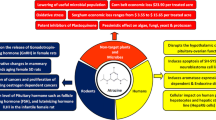Abstract
The proposed method for the differential AOX analysis of water samples was tested for its applicability to differentiate the halogen content of peat samples. For determination of the total and the total organic-bound chlorine, bromine and iodine, peat samples were combusted, and the combustion gases trapped and analyzed by ion chromatography (TX/TOX-IC). The total and the organically bound chlorine, bromine and iodine, respectively, can be determined by two-fold analysis with deviations of around 10%. With respect to chlorine more than a double determination could be required. The limit of quantification is 20 mg kg−1 for chlorine, 2 mg kg−1 for bromine and 1 mg kg−1 for iodine, if 25 mg of peat is combusted. The most crucial step of the analysis is the inorganic halogen removal, which is necessary if the organically bound fraction is determined. However, there are some uncertainties about the complete removal of the inorganic halides from the solid samples. Thus, the values of the organically bound fraction have to be discussed as maximal concentrations. Nevertheless, we suggest that the applied method can be useful as a tool for studying the fate of halogens in soils.




Similar content being viewed by others
References
Kühn W (1976) Untersuchungen zur Bestimmung von organischen Chlorverbindungen auf Aktivkohle. Dissertation Universität Karlsruhe
Müller G, Schmitz W (1985) Chemik-Zg 109(12):415–417
Asplund G, Grimvall A, Pettersson C (1989) Sci Total Environ 81/82:239–248
Grøn C, Raben-Lange B (1992) Sci Total Environ 113: 281–286
Öberg G, Grøn DC (1998) Environ Sci Technol 32:1573–1579
Grøn C (1999) Eurochlor. http://www.eurochlor.org/chlorine/science/chemistry.htm. Cited 4 Nov 2002
DIN EN 1485 H14 (1996) Deutsche Einheitsverfahren zur Wasser-, Abwasser- und Schlammuntersuchung. Summarische Wirkungs- und Stoffkenngrößen (Gruppe H) Bestimmung adsorbierbarer organisch gebundener Halogene (AOX). Beuth Verlag, Berlin
DIN 38414 S18 (1989) Deutsche Einheitsverfahren zur Wasser-, Abwasser- und Schlammuntersuchung. Schlamm und Sedimente (Gruppe S) Bestimmung adsorbierbarer organisch gebundener Halogene (AOX). Beuth Verlag, Berlin
Oleksy-Frenzel J, Wischnack S, Jekel M (2000) Fresenius J Anal Chem 366:89–94
Silk PJ, Lonergan GC, Arsenault TL, Boyle CD (1997) Chemosphere 35:2865–2880
Keppler F, Biester H (2003) Chemosphere Special Issue Global Change Science (in press)
Keppler F, Biester H, Putschew A, Schöler HF, Müller G (2002) Geochim Cosmochim Acta 66(15A):A395–A395
Biester H, Kilian R, Hertel C, Schöler H F (2002) Earth Planet Sci Lett 201: 609–620
Bautz J (2000) Forschungsbericht, Umweltgeochemisches-Praktikum, Institut für Umweltgeochemie, Universität Heidelberg
Acknowledgement
The authors are grateful to Harald Biester and Heinz Friedrich Schöler for the good co-operation and providing the samples. We thank J.T.G. Hamilton for reviewing the manuscript and Jochen Bautz for the TOX measurements. A special thank goes to Hella Schmeißer (TU-Berlin) for the support in the laboratory.
Author information
Authors and Affiliations
Corresponding author
Rights and permissions
About this article
Cite this article
Putschew, A., Keppler, F. & Jekel, M. Differentiation of the halogen content of peat samples using ion chromatography after combustion (TX/TOX-IC). Anal Bioanal Chem 375, 781–785 (2003). https://doi.org/10.1007/s00216-003-1797-1
Received:
Revised:
Accepted:
Published:
Issue Date:
DOI: https://doi.org/10.1007/s00216-003-1797-1




